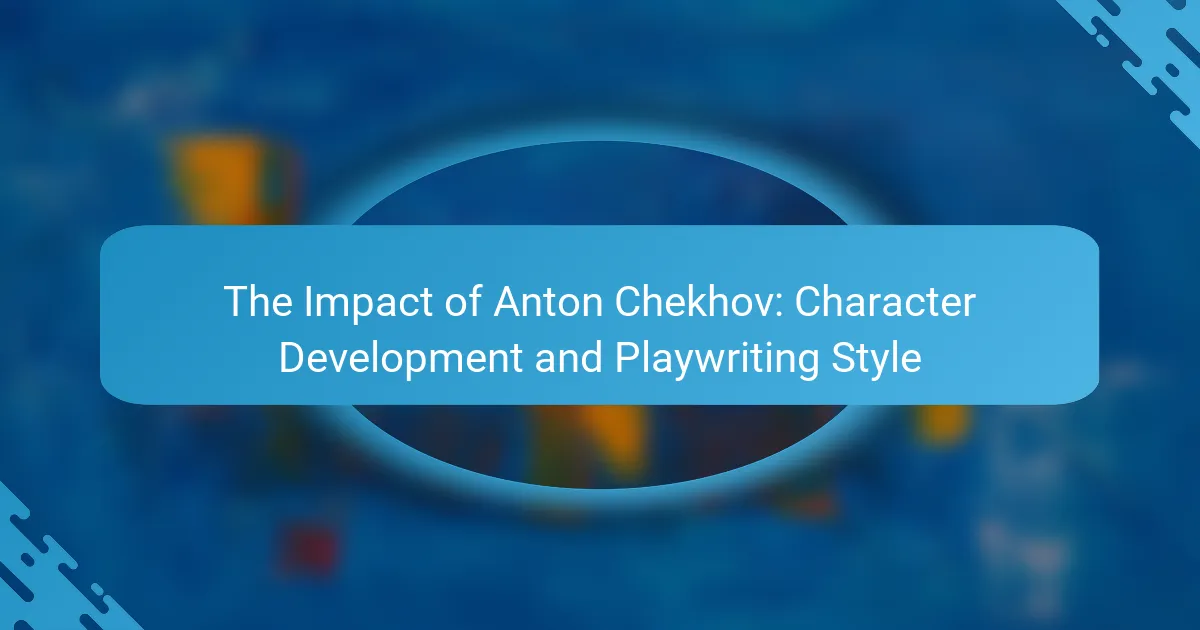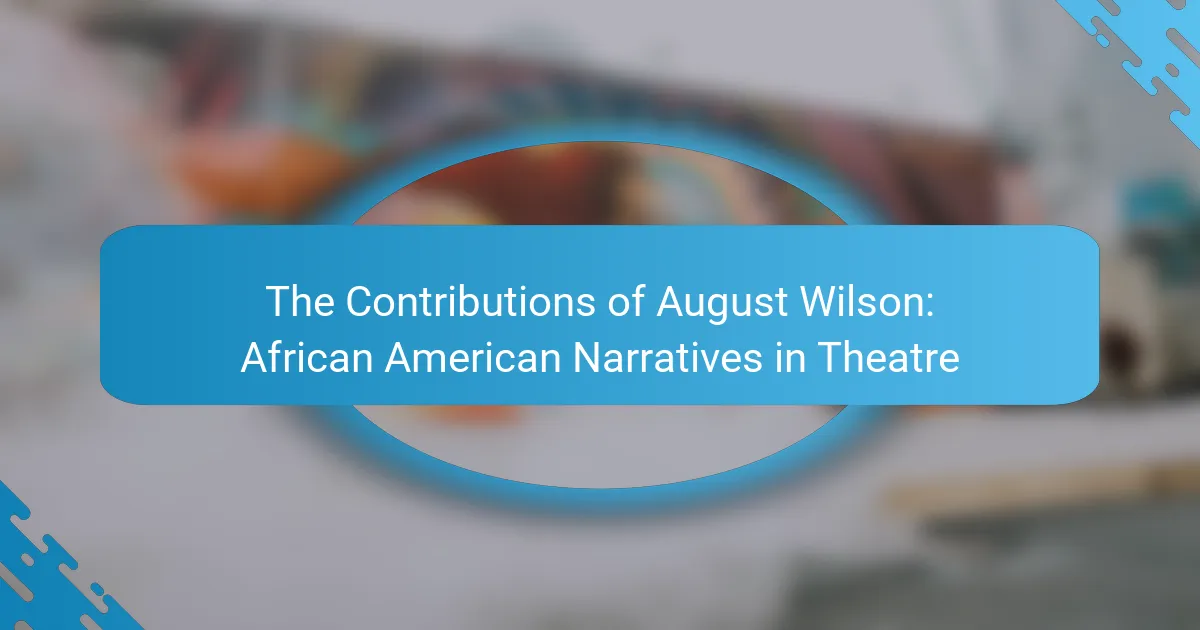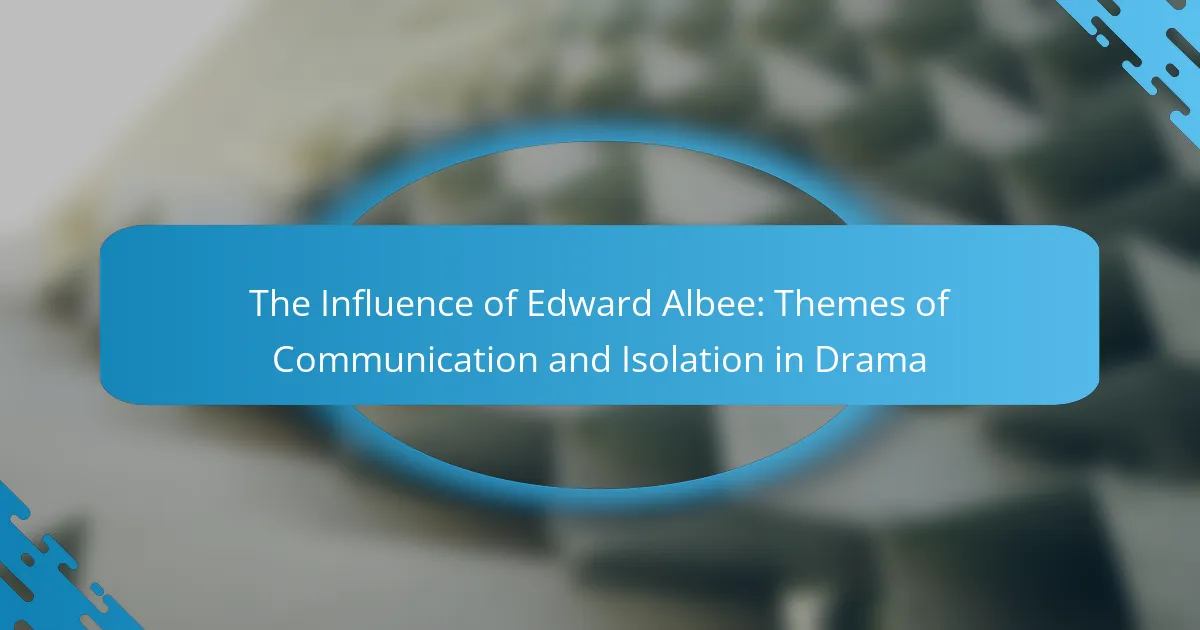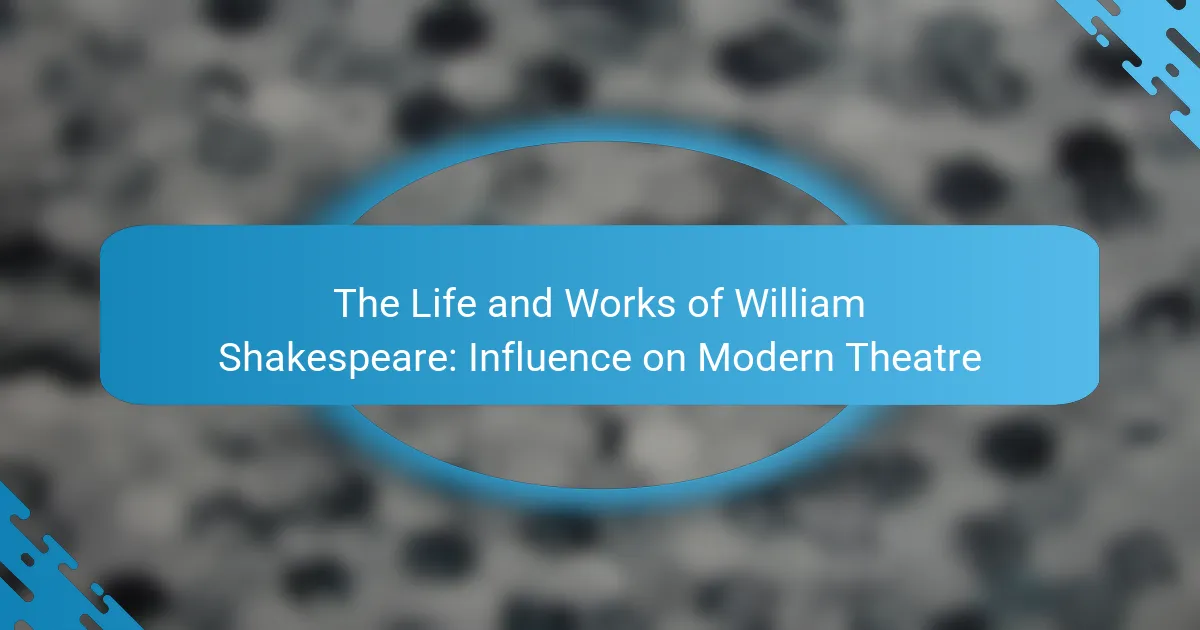Samuel Beckett is a prominent playwright known for his exploration of absurdity, existentialism, and the human condition in his theatrical works. Key themes in Beckett’s plays, such as “Waiting for Godot,” “Endgame,” and “Krapp’s Last Tape,” highlight the illogical aspects of life, the search for meaning in an indifferent universe, and the experiences of isolation and suffering. His characters often confront existential crises, reflecting on their existence and purpose, while the interplay of language and silence underscores the complexity of communication. Beckett’s background, including his Irish heritage and experiences during World War II, significantly shapes his artistic perspective and thematic concerns, making his contributions essential to modern theatre and the absurdist movement.

What are the key themes in the work of Samuel Beckett?
The key themes in the work of Samuel Beckett include absurdity, existentialism, and the human condition. Absurdity manifests in the illogical and nonsensical aspects of life depicted in his plays. Existentialism explores the search for meaning in a seemingly indifferent universe. The human condition is portrayed through isolation, suffering, and the passage of time. Beckett’s characters often face existential crises, reflecting on their existence and purpose. His most famous work, “Waiting for Godot,” exemplifies these themes through the characters’ endless waiting and lack of resolution. The interplay of language and silence in his writing further emphasizes the complexity of communication and understanding.
How does absurdism manifest in Beckett’s plays?
Absurdism manifests in Beckett’s plays through themes of existential despair and the futility of human action. Characters often engage in meaningless dialogue and repetitive actions. This reflects the absurdist belief that life lacks inherent meaning. For example, in “Waiting for Godot,” the characters wait indefinitely for someone who never arrives. This highlights the absurdity of hope and expectation. Additionally, Beckett’s use of minimalistic settings emphasizes isolation and the emptiness of existence. The fragmented narrative structure further illustrates the disjointed nature of reality. Overall, Beckett’s work exemplifies the core principles of absurdism through its exploration of human suffering and the search for purpose.
What are the defining characteristics of absurdism in theatre?
Absurdism in theatre is characterized by the portrayal of the meaningless nature of human existence. It often features illogical plots and nonsensical dialogue. Characters typically experience a sense of disconnection and isolation. Time and space are often distorted, creating an unsettling atmosphere. The absurdist style frequently employs repetition and circular narratives. Existential themes challenge the audience’s perception of reality. The works of playwrights like Samuel Beckett exemplify these traits. For instance, “Waiting for Godot” showcases characters waiting indefinitely, highlighting existential uncertainty.
How does Beckett’s use of language contribute to absurdism?
Beckett’s use of language significantly contributes to absurdism by emphasizing the limitations and failures of communication. His dialogue often features fragmented sentences and nonsensical exchanges. This reflects the absurdist belief that human existence lacks inherent meaning. For example, in “Waiting for Godot,” characters engage in repetitive and circular conversations. These conversations highlight the futility of seeking clarity and understanding. Beckett’s minimalist style strips language of traditional narrative functions. This creates a sense of disorientation and alienation in the audience. Ultimately, his language embodies the core tenets of absurdism, showcasing the absurdity of the human condition.
What existential themes are prevalent in Beckett’s works?
Beckett’s works prominently feature themes of absurdity, isolation, and the search for meaning. Absurdity is illustrated through characters facing meaningless situations, as seen in “Waiting for Godot.” Isolation is depicted in the emotional and physical separations among characters, notably in “Endgame.” The search for meaning is a core struggle, with characters often questioning their existence and purpose. These themes reflect existential philosophy, emphasizing the human condition’s inherent uncertainty. Beckett’s unique style and dialogue further reinforce these existential motifs, creating a profound impact on modern literature and theatre.
How does the concept of existentialism influence character development?
Existentialism profoundly influences character development by emphasizing individual choice and the search for meaning. Characters often grapple with their existence and the absurdity of life. This struggle leads to complex psychological portrayals. In Samuel Beckett’s works, characters like Vladimir and Estragon exemplify this. They face existential dilemmas and engage in repetitive dialogue, reflecting their search for purpose. Their interactions reveal the tension between hope and despair. This dynamic showcases the human condition’s inherent uncertainties. Beckett’s characters often embody the existential belief that meaning is not given but created. This perspective shapes their actions and relationships throughout the narrative.
What role does isolation play in Beckett’s narratives?
Isolation is a central theme in Beckett’s narratives. It serves to highlight the characters’ existential struggles and the absurdity of human existence. In works like “Waiting for Godot,” characters experience profound loneliness despite their interactions. The setting often emphasizes desolation, reinforcing feelings of abandonment. Beckett uses isolation to explore the limits of communication and understanding. This theme reflects the human condition and the search for meaning in a chaotic world. The characters’ isolation leads to moments of introspection and existential questioning. Overall, isolation is a crucial device that deepens the exploration of absurdist and existential themes in Beckett’s work.

How does Samuel Beckett’s background influence his theatrical work?
Samuel Beckett’s background significantly influences his theatrical work. He was born in Dublin, Ireland, in 1906. His Irish heritage is evident in the themes of isolation and existentialism present in his plays. Beckett’s education included studying French, Italian, and English literature, which shaped his writing style and thematic concerns. He lived in Paris during World War II, experiencing the turmoil of the era, which deepened his exploration of absurdity. His relationships with influential figures, such as James Joyce, also impacted his artistic development. Beckett’s personal struggles with depression and existential questions are reflected in characters like Vladimir and Estragon in “Waiting for Godot.” These elements combine to create a unique voice in modern theatre that critiques human existence and communication.
What biographical elements are significant in understanding his plays?
Samuel Beckett’s biographical elements significantly influence understanding his plays. His Irish heritage is crucial, reflecting themes of isolation and existential despair. Beckett’s experiences during World War II shaped his views on human suffering and absurdity. His relationship with language is evident, stemming from his background in literature and philosophy. Beckett’s personal struggles with depression inform the bleakness in his work. His fascination with silence and absence mirrors his own life experiences. The influence of French culture, where he spent much of his life, is apparent in his writing style. These elements collectively provide context for the themes in his plays.
How did Beckett’s early life shape his views on existence?
Samuel Beckett’s early life significantly influenced his views on existence. He was born in Dublin, Ireland, in 1906. This environment exposed him to a mix of cultural and philosophical ideas. The influence of Irish Catholicism instilled a sense of existential questioning in him. His education at Trinity College introduced him to modernist literature and philosophy. Beckett’s experiences during World War II deepened his sense of absurdity in human existence. He witnessed the chaos and suffering of war, which shaped his bleak outlook. These formative experiences are reflected in his works, emphasizing themes of despair and the search for meaning.
What impact did historical context have on his writing style?
Historical context significantly influenced Samuel Beckett’s writing style. The aftermath of World War II and the rise of existential philosophy shaped his themes. Beckett’s work reflects the disillusionment of the post-war era. His minimalist approach mirrors the stark realities of life during that time. The absurdity of existence became a central motif in his plays. This aligns with the existential belief that life lacks inherent meaning. Additionally, Beckett’s use of fragmented dialogue highlights the chaos of the human condition. The historical climate fostered a unique voice that challenged traditional narrative forms.
How did Beckett’s experiences in World War II influence his themes?
Beckett’s experiences in World War II profoundly influenced his themes of absurdity and existentialism. His time in the war exposed him to the chaos and futility of human existence. This led to a focus on the meaninglessness of life in his works. The trauma he experienced is reflected in characters that confront despair and isolation. Beckett’s writing often portrays a bleak view of human relationships. The war also heightened his interest in the fragility of language and communication. These themes are evident in plays like “Waiting for Godot.” Overall, his wartime experiences shaped a literary style that grapples with the absurdity of the human condition.
What specific events from the war are reflected in his works?
Samuel Beckett’s works reflect specific events from World War II. His experiences during the war influenced his writing style and themes. The chaos and destruction of the war are evident in his portrayal of human despair. The absurdity of existence, a central theme in his works, mirrors the senselessness of war. Beckett’s characters often face existential crises, reflecting the disillusionment of that era. His play “Waiting for Godot” encapsulates the waiting and uncertainty felt during wartime. The fragmentation of language in his texts represents the breakdown of communication during conflict. Overall, Beckett’s works serve as a commentary on the impact of war on the human condition.
How does the aftermath of war shape the characters in his plays?
The aftermath of war profoundly shapes the characters in Samuel Beckett’s plays. Characters often exhibit feelings of disillusionment and despair. They struggle with themes of isolation and existential uncertainty. The trauma of conflict influences their interactions and perceptions of reality. For instance, in “Waiting for Godot,” characters grapple with the meaninglessness of existence. This reflects the post-war sentiment of futility. Beckett’s portrayal of fragmented identities illustrates the psychological scars left by war. His characters often embody a sense of paralysis, mirroring societal stagnation after conflict. Overall, the experiences of war create a backdrop for exploring human vulnerability and resilience.

What are the most notable plays by Samuel Beckett and their significance?
The most notable plays by Samuel Beckett include “Waiting for Godot,” “Endgame,” and “Krapp’s Last Tape.” “Waiting for Godot” is significant for its exploration of existential themes and the absurdity of human existence. It features two characters, Vladimir and Estragon, who wait for someone named Godot, symbolizing the search for meaning. “Endgame” presents a bleak view of life through its characters Hamm and Clov, who navigate a post-apocalyptic world. It highlights themes of dependency and the cyclical nature of existence. “Krapp’s Last Tape” focuses on the passage of time and memory. The protagonist listens to recordings of his younger self, reflecting on lost opportunities. Each play challenges traditional narrative structures and emphasizes the human condition’s absurdity. Beckett’s work has profoundly influenced modern theatre, shaping the absurdist movement.
What are the key features of “Waiting for Godot”?
“Waiting for Godot” features two main characters, Vladimir and Estragon, who wait for someone named Godot. The play is characterized by its minimalist setting, which emphasizes the themes of absurdism. Dialogue in the play often reflects existential questions and the nature of human existence. The narrative structure is non-linear, lacking traditional plot progression. Time is portrayed as cyclical, with repetitive actions and conversations. The play employs dark humor to explore serious themes. Symbolism is prevalent, particularly in the character of Godot, who represents hope or the unknown. The absence of resolution at the end reinforces the play’s existential themes.
How does “Waiting for Godot” exemplify absurdist theatre?
“Waiting for Godot” exemplifies absurdist theatre through its themes of existential uncertainty and the absurdity of human existence. The play features two characters, Vladimir and Estragon, who wait endlessly for someone named Godot. Their conversations are often nonsensical and circular, highlighting the futility of their expectations. The lack of a traditional plot structure emphasizes the randomness of life. Time is depicted as fluid and meaningless, with days passing without progress. The characters’ repeated actions and dialogues reinforce the idea of life’s monotony. Additionally, the play’s ambiguous ending leaves the audience questioning the purpose of waiting. This aligns with absurdist principles that challenge rational thought and meaning.
What existential questions does “Waiting for Godot” raise?
“Waiting for Godot” raises fundamental existential questions about the nature of existence and the human condition. It prompts inquiries into the meaning of life and the purpose of waiting. The characters, Vladimir and Estragon, embody the struggle against despair and the search for significance. Their endless waiting symbolizes the human experience of uncertainty and futility. The play questions whether life has inherent meaning or if individuals must create their own purpose. It also explores themes of time, memory, and the inevitability of death. Through its absurdist lens, the work challenges traditional narratives and confronts the audience with the absurdity of existence.
What themes are explored in “Endgame”?
“Endgame” explores themes of existentialism, absurdity, and the human condition. The characters experience a sense of futility and hopelessness. They confront the inevitability of death and the passage of time. The setting reflects a bleak, post-apocalyptic world. Communication is often fragmented and nonsensical. This illustrates the struggle for meaning in a seemingly indifferent universe. The relationship between Hamm and Clov highlights dependency and power dynamics. Overall, these themes emphasize the absurdity of existence and the search for purpose.
How does the setting of “Endgame” contribute to its themes?
The setting of “Endgame” significantly contributes to its themes of existentialism and absurdism. The play takes place in a bleak, post-apocalyptic environment. This desolate backdrop reflects the characters’ isolation and despair. Clov and Hamm are confined to a small, dark room, symbolizing entrapment. The limited space emphasizes the monotony of their existence. The absence of a clear outside world suggests hopelessness. Additionally, the setting reinforces the absurdity of life and human relationships. The starkness of the environment mirrors the starkness of their interactions. Thus, the setting is integral to illustrating the overarching themes within the play.
What character dynamics are essential to understanding “Endgame”?
The essential character dynamics in “Endgame” revolve around the relationships of dependency and power. Hamm’s reliance on Clov illustrates a master-servant dynamic. Clov’s struggle for autonomy highlights his conflicting emotions toward Hamm. Their interactions reflect themes of existential despair and the search for meaning. The characters’ dialogues reveal their bleak outlook on life. Additionally, Nagg and Nell’s presence adds layers of familial obligation and decay. Their interactions further emphasize the absurdity of existence. Each character embodies elements of suffering and resignation within their confined reality. These dynamics are crucial for understanding the overarching themes of absurdism in Beckett’s work.
What practical insights can be drawn from studying Beckett’s works?
Studying Beckett’s works reveals insights into the human condition and existential themes. His plays often illustrate the absurdity of life and the struggle for meaning. Characters frequently face isolation and despair, reflecting real human experiences. This highlights the importance of communication and connection in overcoming existential crises. Beckett’s minimalist style emphasizes the significance of language and silence in conveying emotion. His exploration of time challenges perceptions of reality and existence. Overall, Beckett’s works serve as a profound commentary on life’s inherent uncertainties.
How can modern playwrights apply Beckett’s techniques in their own writing?
Modern playwrights can apply Beckett’s techniques by embracing minimalism and existential themes. They can focus on sparse dialogue and settings to enhance the absurdity of human existence. Utilizing pauses and silence can create tension and emphasize emotional states. Playwrights should explore the concept of waiting, reflecting the uncertainty of life. Non-linear narratives can be employed to challenge traditional storytelling. Characters may embody a sense of futility, mirroring Beckett’s protagonists. Incorporating dark humor can provide a unique lens on serious subjects. Analyzing Beckett’s use of repetition can help in creating rhythm and depth in dialogue. These techniques can lead to innovative theatrical experiences that resonate with contemporary audiences.
What lessons about human existence can audiences learn from Beckett’s plays?
Audiences can learn profound lessons about the absurdity and meaninglessness of human existence from Beckett’s plays. His works often depict characters trapped in repetitive, futile situations. This illustrates the struggle against the void and highlights the inherent loneliness of existence. Beckett’s characters frequently engage in circular dialogue, emphasizing the lack of progress or resolution in life. The themes of waiting and uncertainty are central, as seen in “Waiting for Godot.” This play showcases the existential belief that life is often characterized by inaction and ambiguity. Beckett’s portrayal of human relationships reveals the isolation individuals face, even in companionship. His exploration of time and memory further underscores the transient nature of life. Ultimately, Beckett’s plays challenge audiences to confront the absurdity of their own lives and the search for meaning in a seemingly indifferent universe.
The main entity of the article is Samuel Beckett, a prominent playwright known for his contributions to absurdist theatre and existential themes. The article explores key themes in Beckett’s work, including absurdity, existentialism, and the human condition, highlighting how these concepts manifest in his notable plays such as “Waiting for Godot” and “Endgame.” It discusses the influence of Beckett’s background, historical context, and personal experiences on his writing style and character development. Additionally, the article analyzes the significance of isolation, language, and communication within his narratives, providing insights into the lessons audiences can learn from his exploration of human existence.



